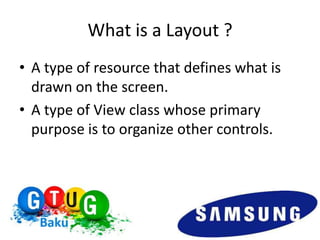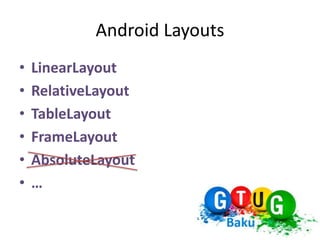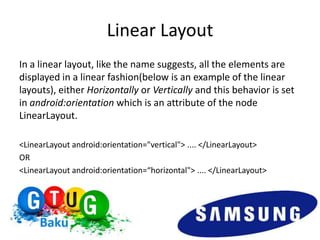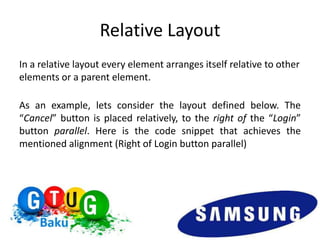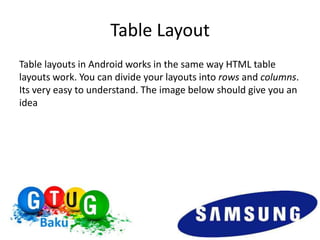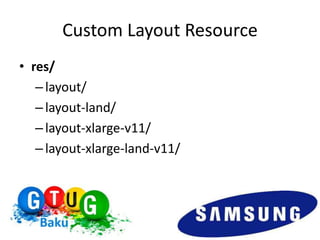Android Erası 2 - UI və layoutlar
- 2. What is a Layout ? ŌĆó A type of resource that defines what is drawn on the screen. ŌĆó A type of View class whose primary purpose is to organize other controls.
- 3. Why a Layout ? ŌĆó More than 300 devices with different ŌĆō Screen sizes and dimensions ŌĆō Screen densities ŌĆō Android versions ŌĆō OEM skins ŌĆō Control interfaces
- 4. Android Layouts ŌĆó LinearLayout ŌĆó RelativeLayout ŌĆó TableLayout ŌĆó FrameLayout ŌĆó AbsoluteLayout ŌĆó ŌĆ”
- 5. Linear Layout In a linear layout, like the name suggests, all the elements are displayed in a linear fashion(below is an example of the linear layouts), either Horizontally or Vertically and this behavior is set in android:orientation which is an attribute of the node LinearLayout. <LinearLayout android:orientation="vertical"> .... </LinearLayout> OR <LinearLayout android:orientation=ŌĆ£horizontal"> .... </LinearLayout>
- 7. Relative Layout In a relative layout every element arranges itself relative to other elements or a parent element. As an example, lets consider the layout defined below. The ŌĆ£CancelŌĆØ button is placed relatively, to the right of the ŌĆ£LoginŌĆØ button parallel. Here is the code snippet that achieves the mentioned alignment (Right of Login button parallel)
- 9. Table Layout Table layouts in Android works in the same way HTML table layouts work. You can divide your layouts into rows and columns. Its very easy to understand. The image below should give you an idea
- 10. Table Layout
- 11. Absolute Layout Non-professional and not recommended layout !!!
- 12. Custom Layout Resource ŌĆó res/ ŌĆō layout/ ŌĆō layout-land/ ŌĆō layout-xlarge-v11/ ŌĆō layout-xlarge-land-v11/
- 13. Density Independent Pixels ŌĆó dp or dip
- 14. Think, Design, Code !!!
- 15. Rajab Davudov Senior Developer at Azerfon radjab@gmail.com https://market.android.com/developer?pub=RADJAB http://gplus.to/radjab http://www.fb.me/rajab.davudov http://www.linkedin.com/in/radjab Market QR Code


